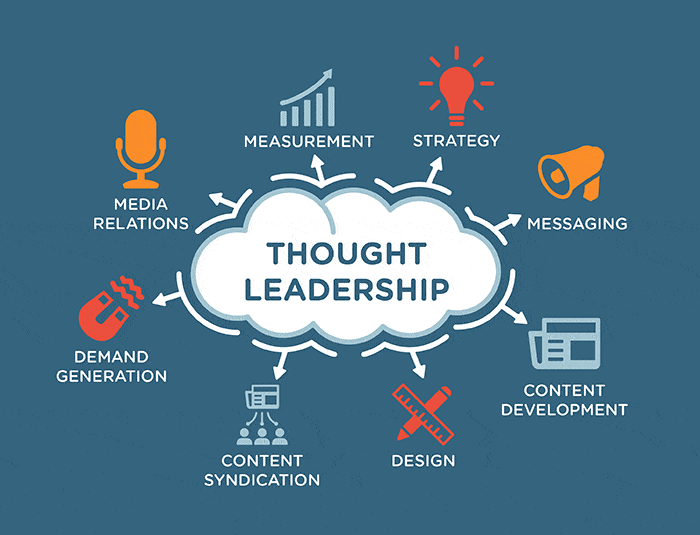Thought leadership is the foremost means for individuals to establish credibility in any industry. According to Forrester, thought leadership has a more significant impact on potential buyers compared to other forms of marketing. And not to mention, 83% of buyers believe it helps them trust an organization.
A thought leader is someone who commands authority by demonstrating knowledge and expertise in a particular field. From CEOs to team leaders, many people are using thought leadership to boost brand awareness and strengthen consumer trust.
Creating content such as blogs, podcasts, or video interviews is one of the best ways to become a thought leader. Here are seven ways individuals can leverage content marketing to build thought leadership.
Seven Ways to Build Thought Leadership
- Address timely topics
- Be active on social media
- Blog consistently
- Offer fresh perspectives
- Conduct and offer expert interviews
- Publish a book
- Create podcasts
1. Address timely topics
Thought leadership requires staying up-to-date on the latest news and trends. Individuals often publish blog posts or articles on trends and issues that impact their industry. Publishing content on the brand’s blog or in industry trade magazines is a great way to build one’s expertise. Is there a new law or regulation affecting the industry? Additionally, be on the lookout for trends that are growing or declining. Individuals can capitalize on newsworthy topics to present their own thoughts and predictions in their field.
Use Google Alerts to get notifications on new web content. By searching a keyword and creating an alert, users receive emails letting them know when the tool finds matching keywords on the web. Google Trends is a great way to enter keywords and topics to see what users are searching on the Internet. These tools help individuals stay current and create relevant content for their audience.
2. Be active on social media
Having a social media presence is essential to growing thought leadership. Be sure to post relevant content, share interesting articles, and comment on trending topics. Join groups on Facebook, and answer questions and offer advice to those seeking guidance. However, group members will notice those offering knowledge and will view them as an authority figure in their space.
3. Blog consistently
The key to building thought leadership with content is to blog regularly. Make sure that blog posts are relevant to the industry and add value to readers’ lives. For instance, consistency and frequency are critical. Additionally, posting content sporadically isn’t enough as audiences want someone they can rely on for steady content. According to HubSpot, publishing 9-15 articles a month can increase inbound leads and traffic significantly. Posting more often than this can yield even greater results. Brands that blog 15 times or more per month get five times more site traffic than those that do not blog.
Publishing content frequently and consistently makes it more likely for individuals to reach audiences and become a trusted authority.
4. Offer a fresh perspective
Although it can be challenging to do something that no one else is, being innovative garners attention and helps individuals stand out. Creating content gives individuals a voice to communicate these innovations to audiences on a broader scale. For example, consider ways to offer unique perspectives and provide content experience. Being an innovator can be daunting, but individuals that dare to do something cutting-edge and original will stand out.
5. Conduct and offer thought leadership expert interviews
Interviews that demonstrate one’s expertise are powerful. For those just starting to develop thought leadership, it’s a good idea to post interviews on multiple channels, such as a blog, podcast, or video platforms. This is an excellent way for CEOs or team leaders to give audiences content that meets their needs while increasing their authority by association.
Once individuals have reached thought leader status, it’s crucial that they offer others their expertise as often as possible. Providing knowledge and perspective on industry topics leads to increased credibility and trust.
6. Publish a book for thought leadership
Writing a book filled with industry expertise is synonymous with thought leadership. Moreover, books can garner considerable attention and establish a person as a trustworthy authority in his or her niche. Individuals can choose the route of a traditional book or self-publish an eBook. eBooks can provide more value than blog content and are an affordable way to elevate a person’s authority. If successful, eBooks can also help land a traditional publishing contract in the future.
7. Create podcasts
Lastly, podcasting is an accessible way for individuals to share their industry expertise. According to Edison Research, 73 million people in the United States listened to podcasts monthly in 2018, and 48 million listened weekly. It’s no wonder why so many people are using podcasts to build trust and loyalty among their audiences. Unlike blogs, podcasts offer the advantage of a human voice to convey the emotion behind the message. People can also listen to podcasts while doing other activities, such as commuting or cooking.
Using podcasts to share ideas and insights goes a long way in developing thought leadership.
And companies aren’t the only ones that can build thought leadership. Following these content strategies, individuals can become thought leaders easily. By investing the time and effort, executives and team leaders can utilize a variety of content to establish their authority and grow their brand exponentially.
Albizu Garcia is co-founder and CEO of Gain, a marketing technology company that automates the social media and content publishing workflow for agencies and social media managers, their clients and anyone working in teams.







